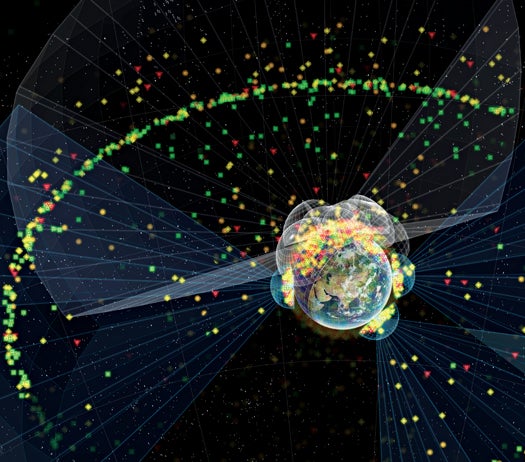The Air Force’s Space Fence System Monitors Orbital Debris To Prevent High-Speed Collisions
On February 10, 2009, a U.S. and a Russian satellite collided 500 miles above Siberia, adding at least 2,000 chunks...

On February 10, 2009, a U.S. and a Russian satellite collided 500 miles above Siberia, adding at least 2,000 chunks to the roughly 100 million pieces of debris currently orbiting Earth. These scraps of satellites, abandoned rocket parts, jettisoned fuel and flecks of paint travel between 7,000 and 18,000 miles an hour, colliding with increasing frequency, which could lead to a feedback loop known as the Kessler syndrome.
If the cycle continues unabated, a collision between a manned spacecraft and debris is inevitable. A month after the satellite crash, the International Space Station was evacuated for fear of a collision with a five-inch piece of an old engine. While cleanup efforts are under way (Russia has pledged $2 billion), the U.S. is launching the Space Fence system in 2015 to track objects in low Earth orbit and direct trash-collection missions.
How It Works:
Mission Control
Lockheed Martin and Raytheon are competing for a $3.5-billion contract to build the Space Fence system, which will use radar to detect and track objects in low Earth orbit. Data will route to air Force bases in Florida and California.
Location
With at least two radar stations each the size of a football field, Space Fence will provide maximum visibility in both hemispheres—Western Australia, Ascension Island and Kwajalein Atoll in the Pacific ocean are all potential host sites.
Database
The Air Force has a catalog of about 20,000 of the 100 million objects in orbit and cannot detect anything smaller than 11 inches in diameter. The new system will be able to handle 100,000 objects and detect debris 0.8 inches across.
Radar
Space Fence uses the same type of radar as Navy warships, and its waves fan out across sections of sky, identifying unknown objects and cataloging them to ensure that flight paths remain debris-free.